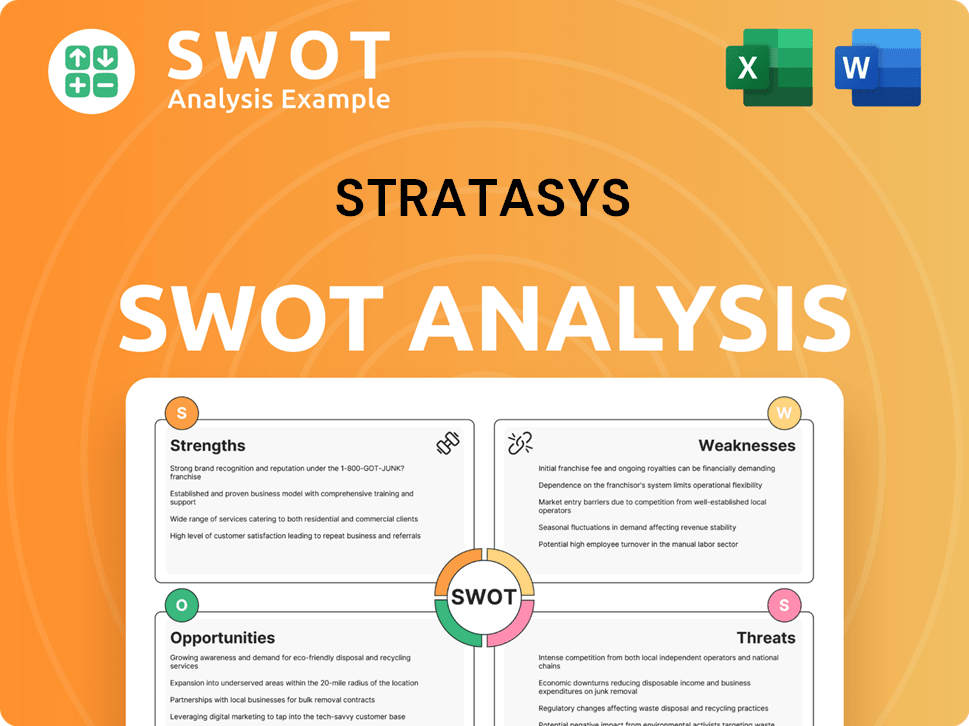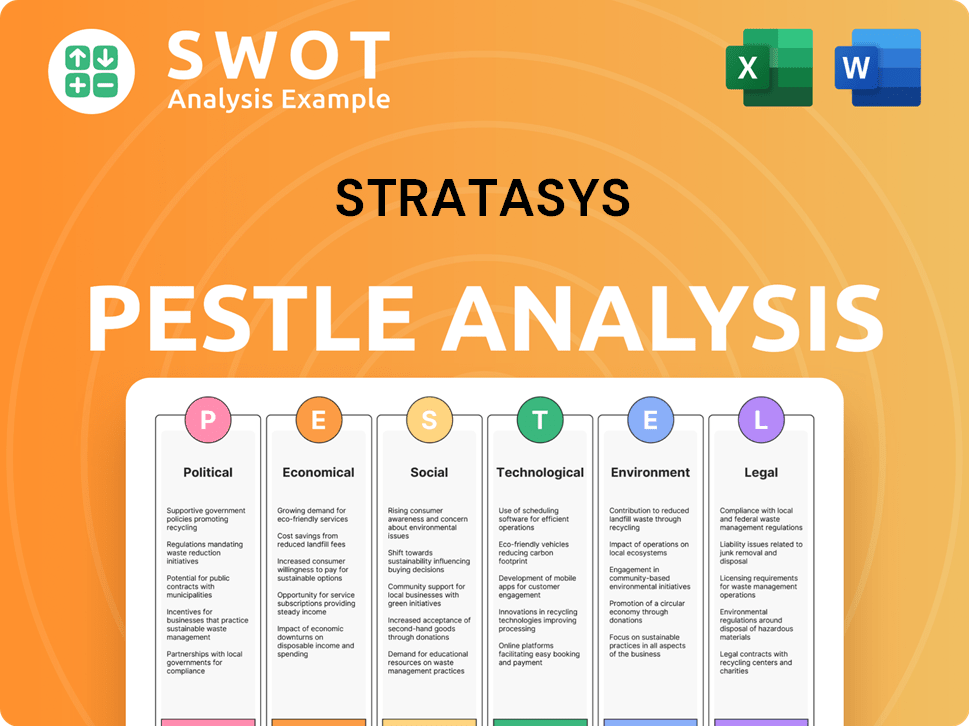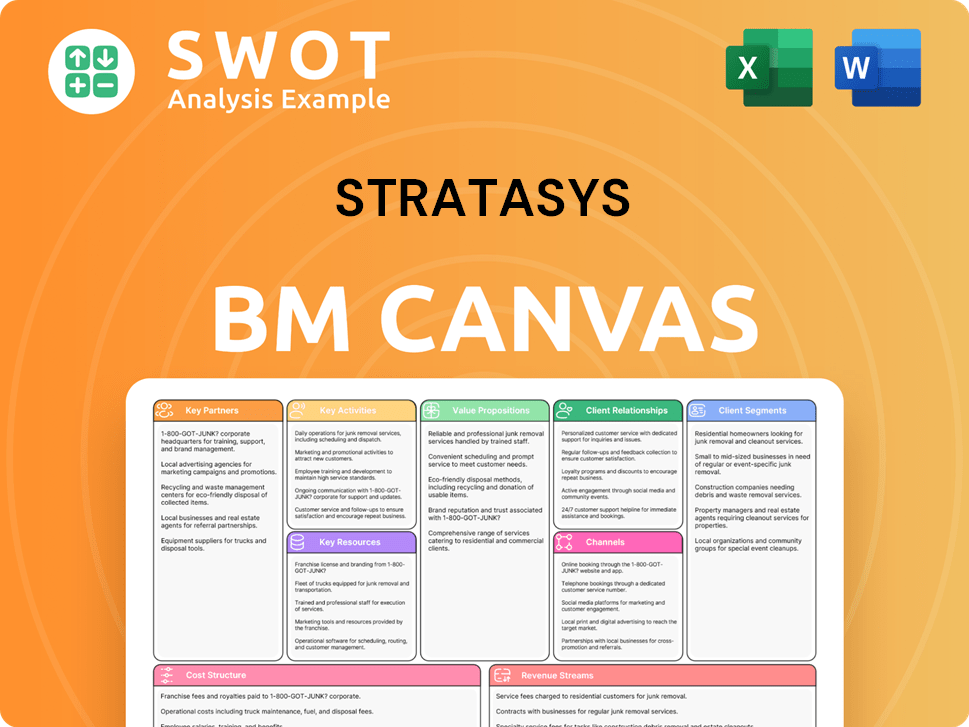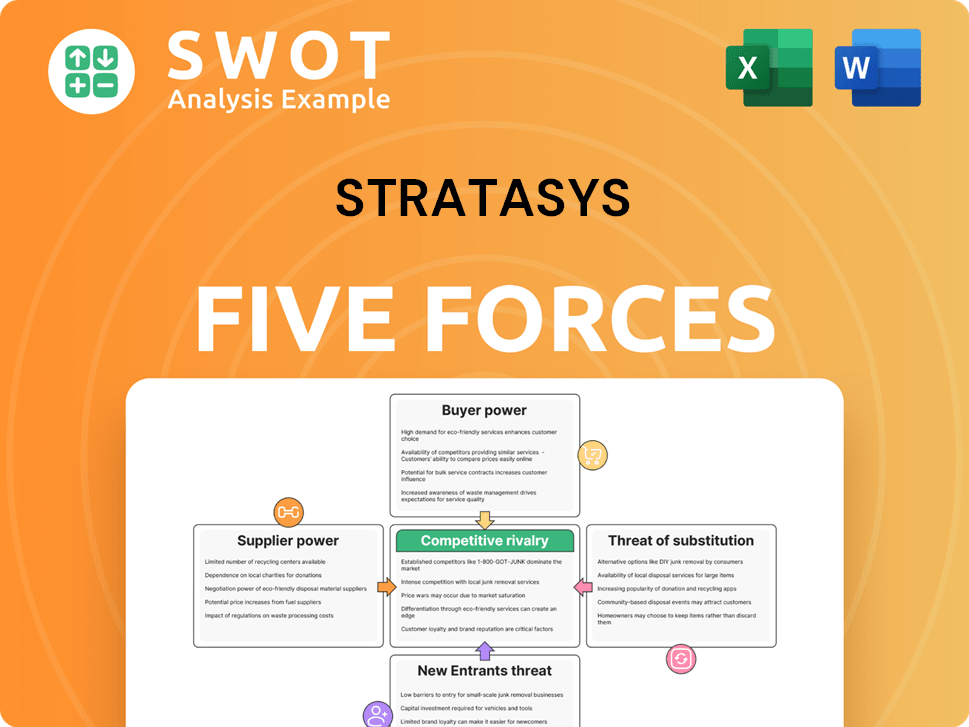Stratasys Bundle
Who Buys from Stratasys?
The rise of 3D printing is reshaping industries, and Stratasys is at the forefront of this revolution. Understanding the company's customer demographics and target market is crucial for anyone looking to navigate the evolving landscape of additive manufacturing. From its humble beginnings, Stratasys has transformed, making it essential to analyze its current customer profile.

Delving into Stratasys's customer base reveals a fascinating evolution, from early adopters in rapid prototyping to a diverse range of industries embracing 3D printing for end-use parts. This exploration of Stratasys's target market will uncover the specific customer needs, geographical distribution, and company size demographics that define its success. Analyzing the company's customer acquisition and retention strategies provides valuable insights into the dynamics of the 3D printing market and the future of additive manufacturing customers.
Who Are Stratasys’s Main Customers?
The primary customer segments for Stratasys are businesses (B2B) across various industries. The company has shifted its focus from prototyping to industrial manufacturing and full-scale production. This shift is evident in the increasing revenue from manufacturing applications.
Key customer segments include aerospace, automotive, healthcare, defense, and consumer goods. These sectors require reliability, performance, and long-term support. Stratasys's customer profile is defined more by industry, application needs, and operational scale than by traditional demographics.
Understanding the customer demographics of Stratasys involves analyzing their industry focus and the specific needs of each sector. For example, the aerospace industry's demand for 3D-printed parts is projected to reach $3.3 billion by 2025, which indicates a significant growth area for the company. The company's target market is also expanding in areas like dental solutions.
The Stratasys target market primarily consists of businesses across multiple sectors, with a strong emphasis on industrial applications. The company's customer base is defined by industry-specific needs and operational scale. Stratasys focuses on providing solutions that meet the demanding requirements of sectors like aerospace and healthcare.
Stratasys serves industries such as aerospace, automotive, healthcare, and consumer goods. The company's solutions are tailored to meet the specific needs of each sector. Manufacturing applications accounted for 36% of Stratasys's total revenue in 2024, showing a shift in focus.
The healthcare sector saw a 15% revenue increase in 2023. The automotive sector is expected to grow by 18% in 2024. Stratasys is also expanding in the dental market, particularly in Europe, with new partnerships in early 2025. This expansion demonstrates the company's adaptation to market trends.
Stratasys is actively expanding its presence, particularly in Europe. New partnerships in Spain and Germany are aimed at distributing solutions like TrueDent™ digital dentures. The European denture market is projected to grow from $2.19 billion in 2023 to $2.45 billion by 2028.
Stratasys's ideal customers are businesses in sectors like aerospace, automotive, and healthcare. These customers require advanced 3D printing and additive manufacturing solutions. The company's focus is on delivering reliable and high-performance products to meet the specific needs of each industry.
- Aerospace: Demand for 3D-printed parts is projected to reach $3.3 billion by 2025.
- Healthcare: Significant revenue growth, with new partnerships in the dental market.
- Automotive: Expected to grow by 18% in 2024.
- Dental: The European denture market is a growing segment for Stratasys.
Stratasys SWOT Analysis
- Complete SWOT Breakdown
- Fully Customizable
- Editable in Excel & Word
- Professional Formatting
- Investor-Ready Format

What Do Stratasys’s Customers Want?
Understanding the customer needs and preferences is crucial for any company, and for Stratasys, this means focusing on the evolving demands of the 3D printing market. The company's success hinges on its ability to meet the specific requirements of its diverse customer base. This involves providing solutions that address both practical and psychological drivers for adopting additive manufacturing technologies.
The customer profile of Stratasys encompasses a wide range of industries, each with unique needs. These customers are looking for innovative solutions that can enhance their product development processes and give them a competitive edge. This includes the ability to create complex geometries, produce durable parts, and achieve high levels of accuracy.
The purchasing behaviors of Stratasys's customers are influenced by the desire for efficient product development and reduced tooling costs. They also seek the capability for small to medium-size production runs. The psychological drivers include innovation and the ability to bring new ideas to life with speed and precision. Practical drivers include the need for reliable, high-performance systems and comprehensive support.
Customers require the ability to create complex geometries, produce strong and durable parts, and achieve high accuracy and repeatability.
Purchasing decisions are influenced by the desire for efficient product development, reduced tooling costs, and the capability for small to medium-size production runs.
Psychological drivers include the need for innovation, competitive advantage, and the ability to bring new ideas to life with speed and precision.
Practical drivers involve the need for reliable, high-performance systems and comprehensive support.
Commitment to customer satisfaction is a core value, aiming to deliver unique solutions to meet specific needs.
Continuous innovation in technologies and materials addresses common pain points.
To address these needs, Stratasys continually innovates its technologies and materials. For instance, FDM (Fused Deposition Modeling) works with production-grade thermoplastics for strong, dimensionally stable parts, while PolyJet enables smooth, accurate parts. The company also focuses on developing new polymers and improving existing ones to broaden applications. Feedback and market trends have influenced product development, leading to new product launches. For example, the H350 3D Printer for industrial clients and new materials like polycarbonate electrostatic discharge (ESD) for electronic manufacturing. Stratasys also tailors its offerings through strategic partnerships, such as collaborations to deploy 3D printing in automotive supply chains or with aerospace and defense companies for mission-critical applications. Understanding the Marketing Strategy of Stratasys provides further insights into how the company positions itself to meet these customer needs.
Stratasys offers a range of technologies and solutions to meet diverse customer needs in the 3D printing market.
- FDM Technology: Uses production-grade thermoplastics for strong and dimensionally stable parts.
- PolyJet Technology: Enables smooth, accurate parts with microscopic layer resolution.
- New Materials: Development of new polymers and improvements to existing ones, such as polycarbonate ESD for electronic manufacturing.
- Strategic Partnerships: Collaborations to deploy 3D printing in automotive supply chains and with aerospace and defense companies.
Stratasys PESTLE Analysis
- Covers All 6 PESTLE Categories
- No Research Needed – Save Hours of Work
- Built by Experts, Trusted by Consultants
- Instant Download, Ready to Use
- 100% Editable, Fully Customizable

Where does Stratasys operate?
The geographical market presence of Stratasys is substantial, with a global footprint that includes its headquarters in Eden Prairie, Minnesota, U.S., and Rehovot, Israel. The company strategically positions itself in numerous countries, ensuring a broad reach across key markets. This extensive presence is a critical factor in understanding the company's customer demographics and target market.
Stratasys operates in a wide array of countries, including the United States, Israel, Japan, South Korea, India, China, Hong Kong, Singapore, Australia, Brazil, Mexico, Germany, United Kingdom, Denmark, Netherlands, Turkey, United Arab Emirates, Ireland, and Italy. This diverse geographical distribution allows Stratasys to cater to a wide range of industries and customer needs. Understanding this broad reach is essential for any 3D printing market analysis.
While specific market share data by region for 2024-2025 is not explicitly detailed, Stratasys's strategic moves indicate a focus on strengthening its presence in key regions. For instance, in early 2025, Stratasys announced new strategic partnerships with three European dental distributors: Nueva Galimplant in Spain, and Gold Quadrat and Metaux Precieux in Germany. This expansion aims to enhance the distribution of Stratasys's dental 3D printing solutions across Europe, aligning with the projected growth of the European denture market from $2.19 billion in 2023 to $2.45 billion by 2028.
Stratasys strategically forms partnerships to enhance its market presence. These collaborations are vital for penetrating diverse markets and meeting specific customer needs. These partnerships are crucial for understanding how Stratasys identifies its target market.
The company is expanding its focus on digital dentistry, as seen with its European dental distributor partnerships. This strategy aligns with the growth in the dental 3D printing market. This focus highlights Stratasys's target market for medical devices.
In 2024, Stratasys's workforce distribution remained proportionate across various regions. Some shifts from the Americas towards Israel, Europe, and Asia Pacific in 2023 due to acquisitions and hiring, indicating strategic adjustments in its global footprint. This data gives insights into where is Stratasys most popular geographically.
To succeed in diverse markets, Stratasys localizes its offerings and partnerships. They leverage the deep expertise of regional partners, particularly in areas like digital dentistry. This approach helps in defining Stratasys' target audience.
The European denture market is projected to grow significantly, from $2.19 billion in 2023 to $2.45 billion by 2028. This growth presents a significant opportunity for Stratasys. This growth is a key factor in understanding Stratasys' customer segmentation by industry.
Stratasys's global strategy involves a combination of direct operations and strategic partnerships to reach its target market. This approach is essential for customer acquisition strategies. For more insights into their business approach, check out the Growth Strategy of Stratasys.
Stratasys Business Model Canvas
- Complete 9-Block Business Model Canvas
- Effortlessly Communicate Your Business Strategy
- Investor-Ready BMC Format
- 100% Editable and Customizable
- Clear and Structured Layout

How Does Stratasys Win & Keep Customers?
The company, a leader in the 3D printing market, employs a multi-pronged strategy for acquiring and retaining customers. Their approach emphasizes strategic partnerships, innovation, and robust customer support. Marketing efforts, representing approximately 10% of revenue in 2024, are crucial in attracting new customers and expanding their market presence. This focus highlights the importance of understanding the Stratasys customer profile and their needs within the additive manufacturing customers landscape.
A key aspect of their acquisition strategy involves expansion into high-demand sectors like aerospace, automotive, and healthcare. The company leverages platforms like the F3300 to support this growth. Furthermore, they utilize strategic partnerships to broaden their market reach and offer value-added services. These collaborations, such as those with aerospace and defense companies for material development and dental distributors in Europe, aim to deepen existing relationships and acquire new customers, demonstrating a clear understanding of Stratasys's customer segmentation by industry.
For customer retention, the company focuses on recurring revenue streams, particularly through consumables (materials and software). These consumables saw a 7% sequential boost in Q1 2025, indicating continued utilization of existing systems. Customer support and services are also central to their strategy. The company views customers as a major asset and continuously strives to improve support. This commitment, along with the provision of consulting, training, and workflow management, ensures customer success and long-term engagement. To understand the competitive landscape, consider reading about the Competitors Landscape of Stratasys.
The company actively forms partnerships to expand its market reach and enhance service offerings. Collaborations with aerospace and defense companies for material development and with dental distributors are examples. These partnerships are vital for not only acquiring new customers but also for strengthening relationships with existing ones.
The introduction of new products, such as the H350 3D Printer and innovative materials, is a key acquisition driver. These launches cater to evolving customer needs and attract new users. This approach ensures that the company remains at the forefront of the 3D printing market.
The company prioritizes recurring revenue through consumables, including materials and software. The 7% sequential boost in Q1 2025 demonstrates the continued use of existing systems. This strategy ensures a stable revenue stream and strengthens customer loyalty.
Customer support and services are crucial for retention, with the company viewing customers as a major asset. They continuously strive to improve support, providing consulting, training, and workflow management. These services ensure customer success and long-term engagement.
Stratasys Porter's Five Forces Analysis
- Covers All 5 Competitive Forces in Detail
- Structured for Consultants, Students, and Founders
- 100% Editable in Microsoft Word & Excel
- Instant Digital Download – Use Immediately
- Compatible with Mac & PC – Fully Unlocked

Related Blogs
- What are Mission Vision & Core Values of Stratasys Company?
- What is Competitive Landscape of Stratasys Company?
- What is Growth Strategy and Future Prospects of Stratasys Company?
- How Does Stratasys Company Work?
- What is Sales and Marketing Strategy of Stratasys Company?
- What is Brief History of Stratasys Company?
- Who Owns Stratasys Company?
Disclaimer
All information, articles, and product details provided on this website are for general informational and educational purposes only. We do not claim any ownership over, nor do we intend to infringe upon, any trademarks, copyrights, logos, brand names, or other intellectual property mentioned or depicted on this site. Such intellectual property remains the property of its respective owners, and any references here are made solely for identification or informational purposes, without implying any affiliation, endorsement, or partnership.
We make no representations or warranties, express or implied, regarding the accuracy, completeness, or suitability of any content or products presented. Nothing on this website should be construed as legal, tax, investment, financial, medical, or other professional advice. In addition, no part of this site—including articles or product references—constitutes a solicitation, recommendation, endorsement, advertisement, or offer to buy or sell any securities, franchises, or other financial instruments, particularly in jurisdictions where such activity would be unlawful.
All content is of a general nature and may not address the specific circumstances of any individual or entity. It is not a substitute for professional advice or services. Any actions you take based on the information provided here are strictly at your own risk. You accept full responsibility for any decisions or outcomes arising from your use of this website and agree to release us from any liability in connection with your use of, or reliance upon, the content or products found herein.